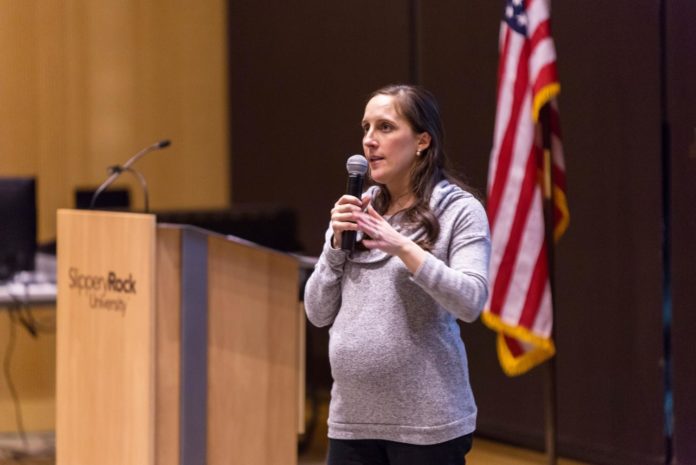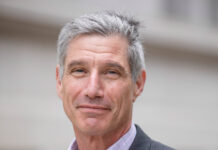Lisa Hamp, a survivor of the Virginia Tech shooting in 2007, spoke in the Smith Student Center theater Wednesday night about her experiences, recovery and the lessons she’s learned since the shooting in her presentation “Virginia Tech: A Survivor’s Perspective.”
Hamp was a mathematics major at Virginia Tech, which she said explained her analytical personality and desire for things to be black and white. Hamp also showed a picture of herself and her roommates in college, who are still some of her best friends to this day.
“Up until this point, I’ve never had a hard challenge, never lost a parent, had never been abused and life was easy. So, when I look at this picture, I think about the most difficult thing in my life, and it was ‘What am I going to wear for my 21st birthday and what bars are we going to go to?’” Hamp said.
On April 16, 2007, Hamp was in room 205 of Norris Hall at 9:40 a.m., roughly two hours after the gunman killed two students in a dormitory. After hearing gunshots outside of the classroom and a teaching assistant and student seeing the shooter, Hamp and her classmates barricaded the door with a table and desks. During this time, people in the room considered plans of escape, including escaping through the window or exiting in the stairwell just outside of the room. While they ultimately stayed in the room until police came, they were unaware at the time that all exits of the building from the second floor were chained shut.
At 9:51 a.m., the police broke into the second floor, and the gunman killed himself in room 211. That day, 32 were killed and 23 were wounded.
After visiting the counseling center on April 21, Hamp left Virginia Tech for the summer on April 23 to return to her hometown in northern Virginia. She saw a second counselor over the summer.
Hamp, after returning in the fall to Virginia Tech, experienced anxiety both inside and outside of the classroom. She also experienced nightmares, loneliness and a weight obsession.
Although she graduated in 2008, received a government job, gained two master’s degrees, got engaged and bought a house, Hamp was unable to get pregnant.
As of result of her infertility, she went to a counselor eight years after the shooting.
“[I] think of it like the dim lightbulbs where each session I went to I was learning more and more about the relationship between the shooting, the trauma I had experienced, how it developed into addiction and that it was more common than I realized,” Hamp said.
As a result of counseling, Hamp created a self-care toolkit, which included a diary, list of people to call and exercise.
She also emphasized the importance of personal recovery, which must take place before community recovery.
Today, Hamp views safety on a spectrum, saying that the middle of the spectrum allows for a person to have a plan in case of an active shooter situation, but not be naïve or hypervigilant.
“Before the shooting, I put myself as a one, someone who’s naïve. I went around and I took my safety for granted. After the shooting, I became a 10, obsessive, hypervigilant. I thought about it 24/7,” Hamp said.
In the classroom, Hamp said that initial clear communication allowed for quick action. The teaching assistant said exactly what she saw instead of instructing students to call for help or hide.
Hamp also stressed that there is not one single solution for solving this issue. While education, policies, locks and access controls all help, only one of these ideas will not be the only solution.
“As much as we want to put it on three fingers like run, hide, fight or avoid, deny, defend, it’s more complex than that. It’s not a one solution fits all,” Hamp said.
Paul Novak, interim executive director of planning and environmental health and safety emergency management administrator, concluded the event with information on SRU’s policies, planning and trainings. SRU has made active shooter training available since 2012, and the first campus-wide drill took place on April 26, 2017.
The second campus-wide active shooter drill will take place on April 19 and will involve one academic building.








